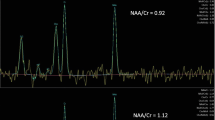Abstract
In six patients with slowly progressive sporadic cerebellar ataxia and cortical multifocal action myoclonus, cerebrospinal fluid (CSF) IgG index was persistently very high (1.2–6.7) and numerous oligoclonal bands were detected. Progressive cognitive impairment and MRI cerebellar and cerebral atrophy were observed. No serum antibodies were found. Various degenerative, metabolic, inflammatory and systemic diseases were excluded. The cerebellum may be the main target of a degenerative or immune process and releases antigens that, enhancing a compartmentalised (auto)immune response, as suggested by the persistent intrathecal activation, could lead to further cerebellar damage. As the frequency of CSF oligoclonal banding in myoclonic ataxia is unknown, our patients’ disease might represent a hitherto unreported entity or a subset of progressive myoclonic ataxia.
Sommario
Descriviamo sei pazienti con atassia cerebellare sporadica e mioclono corticale d’azione multifocale, nel cui liquor i valori dell’indice IgG si mantenevano persistentemente elevati ed erano presenti numerose bande oligoclonali. I pazienti manifestavano un progressivo declino cognitivo e la RM mostrava atrofia cerebellare e cerebrale. In assenza di anticorpi identificabili non era possibile formulare una diagnosi di malattia nota. Suggeriamo che il cervelletto possa essere il principale bersaglio di un processo degenerativo o immuno-mediato e che gli antigeni liberati inducano la produzione di anticorpi che ulteriormente provocano danno cerebrale. Poiché non è nota la frequenza delle bande oligoclonali nel liquor di pazienti con atassia mioclonica, non sappiamo se la malattia qui descritta sia una entità nuova o un sottogruppo delle atassie miocloniche.
Similar content being viewed by others
References
Abele M, Bürk K, Schöls L et al (2002) The aetiology of sporadic adult-onset ataxia. Brain 125:961–968
Darnell RB, Posner JB (2003) Paraneoplastic syndromes involving the nervous system. N Engl J Med 349:1543–1554
Hadjivassiliou M, Boscolo S, Davies-Jones GAB et al (2002) The humoral response in the pathogenesis of gluten ataxia. Neurology 58:1221–1226
Vianello M, Tavolato B, Giometto B (2002) Glutamic acid decarboxylase autoantibodies and neurological disorders. Neurol Sci 23:145–151
Thompson PD (2002) Neurodegenerative causes of myoclonus. In: Myoclonus and paroxysmal dyskinesias. Adv Neurol 89:31–34
Obeso JA (1997) Classification, classical features and treatment of myoclonus. In: Watts RL, Koller WC (eds) Movement disorders, neurologic principles and practice. McGraw-Hill, New York, pp 541–550
Salmaggi A, Carella F, Ciano C et al (1995) Intrathecal immune activation in three patients with progressive myoclonic ataxia. Mov Disord 10:207–210
Brazzelli M, Capitani E, Della Sala S et al (1994) A neuropsychological instrument adding to the description of patients suspected of dementia: the “Milan Overall Dementia Assessment”. J Neurol Neurosurg Psychiatry 57:1510–1517
Rankin J (1957) Cerebral vascular accidents in patients over the age of 60. 2. Prognosis. Scott Med J 2:200–215
Canafoglia L, Ciano C, Panzica F et al (2004) Sensorimotor cortex excitability in Unverricht-Lundborg disease and Lafora body disease. Neurology 63:2309–2315
Panzica F, Canafoglia L, Franceschetti S et al (2003) Movement-activated myoclonus in genetically defined progressive myoclonic epilepsies: EEG-EMG relationship estimated using autoregressive models. Clin Neurophysiol 114:1041–1052
Shibasaki H (2000) Electrophysiological studies of myoclonus. Muscle Nerve 23:321–335
Alekseeva N, Kablinger AS, Pinkston J et al (2005) Hereditary ataxia and behavior. Adv Neurol 96:275–283
Iivanainen M, Leinkki P, Taskinen E et al (1981) CSF oligoclonal bands, immunoglobulins, and viral antibodies in progressive myoclonic epilepsy. Arch Neurol 38:206–208
Marrie RA, Shoubridge EA, Antel JP et al (2001) Unusual imaging findings in progressive myoclonus epilepsy. Epilepsia 42:430–432
Polman CH, Reingold SC, Edan G et al (2005) Diagnostic criteria for multiple sclerosis: 2005 revision to the “McDonald criteria.” Ann Neurol 58:840–846
Tranchant C, Bhatia KP, Marsden CD (1995) Movement disorders in multiple sclerosis. Movement Disorders 10:418–423
Revesz T, Kidd D, Thompson AJ et al (1994) A comparison of the pathology of primary and secondary progressive multiple sclerosis. Brain 117:759–765
Poser CM, Paty DW, Scheinberg LC et al (1983) New diagnostic criteria for multiple sclerosis: guidelines for research protocols. Ann Neurol 13:227–231
Humm AM, Z’Graggen WJ, Bühler R et al (2006) Quantification of central motor conduction deficits in multiple sclerosis patients before and after treatment of acute exacerbation by methylprednisolone. J Neurol Neurosurg Psychiatry 77:345–350
Janssen JC, Godbolt AK, Ioannidis P et al (2004) The prevalence of oligoclonal bands in the CSF of patients with primary neurodegenerative dementia. J Neurol 251:184–188
Monsonego A, Weiner HL (2003) Immunotherapeutic approaches to Alzheimer’s disease. Science 302:834–838
Appel SH, Smith RG, Engelhardt JI, Stefani E (1994) Evidence for autoimmunity in amyotrophic lateral sclerosis. J Neurol Sci 124[Suppl]:14–19
Neumann H (2003) Molecular mechanisms of axonal damage in inflammatory central nervous system diseases. Curr Opin Neurol 16:167–273
Tijssen MAJ, Thom M, Ellison DW et al (2000) Cortical myoclonus and cerebellar pathology. Neurology 54:1350–1356
Author information
Authors and Affiliations
Corresponding author
Rights and permissions
About this article
Cite this article
Testa, D., Ambrosoni, E., Franceschetti, S. et al. Progressive myoclonic ataxia with intrathecal immune activation in six patients. Neurol Sci 28, 199–204 (2007). https://doi.org/10.1007/s10072-007-0821-1
Received:
Accepted:
Published:
Issue Date:
DOI: https://doi.org/10.1007/s10072-007-0821-1




